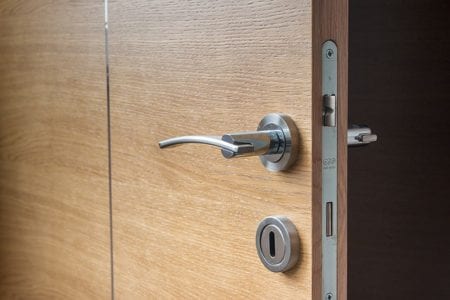
Image credit: qimono
Home doors are designed for many years of service. So it usually happens, but there is no guarantee that at some point the doors will not show flaws demanding attention. More precisely, attention is just beginning to occupy the doors themselves, if there is a creak, the hinges are loosened, the latch does not work, or the door starts to cling to the doorway. Most of the minor problems can be corrected with their own hands without resorting to the services of a master.
To assess the condition of the door, it is necessary to conduct a thorough inspection of all hinges and surfaces. The canvas starts to cling to the door jamb and because of this it is not closed tightly.
To fix the problem it is necessary to mark the places of friction, remove the door from the loops and lay it on the table. The accrued layers of paint should be removed using a chisel or plane. After that, the repair site is sanded with an emery cloth and painted in the desired color.
At the doors that are in operation for many years, loops may loosen, due to which the door will cling to a quarter in the boxes of the box. Strictly speaking, the screws with which the hinges are fastened are ground and they will have to be strengthened.
The door removed from the hinges can simply be placed next to the opening, where it is not necessary to lay the linen. Next, you need to unscrew all the screws and remove the loosened loops. Then take chips, or wooden skewers for barbecue, apply a glue on one edge and drive them into the holes from the screws.
It is necessary to wait until the glue grabs and then cut off the protruding tails. After that, the stitches are made for screwing the screws in the old places and the hinges are attracted by the screws in place. As a rule in such cases, drilling holes for screws is not required, screws with good load are screwed into the old holes.
Most often, the reason for the creaking of the door is an ungainly hinge, and in some cases the canvas creaks when rubbing against the door jamb. As for loops, there are only two options here: Either replace the worn loops with new ones of exactly the same size, or simply apply lubricant to the rubbing parts. For household doors, the use of any oils is not welcome, since the grease squeezed out of the loops will contaminate the linen. The simplest is to buy an aerosol can with graphite grease, slightly lift the door on the hinges and squirt the composition onto the hinge of the hinge. Loops will cease to creak for at least six months, and maybe more. The same applies to the lubrication of the door latch, sometimes it is enough to spray a graphite compound and the lock will again be easily closed.
As for the latch faults, the broken lock should be replaced with a new one, so that it does not jam at the most inopportune moment. If the latch is working, then small problems can be quickly resolved independently.
The loose screws are sealed as in the case of loops. We unscrew the screws, paste the chips, cut the excess and again tighten the screws.
But more often the problem with a latch arises from behind the warped doors. When the tongue of the lock does not fall into the opening on the counter plate when closed, which is respectively mounted on the door frame. In this case, with the lock on the doors, you do not need to do anything, you can only set the adjustment bar on the box.

Image credit: neshom
The bar is removed and the holes from the screws are sealed with chips. Again, the height of the tongue is measured over the not completely closed door, the mark is made with a pencil on the edge of the block bar. Next, you need to measure the depth of immersion of the bar, for this purpose the metal ruler measures the distance between the flat side of the tongue and the opposite edge of the door edge. Then the counterplate is put in place, and the depth of installation is measured by a ruler from the inner edge of the quarter, to the outside of the hole in the bar. If the hole in the opening under the tongue already exists, then it remains to pull the bar into place with screws.
The most laborious correction can be with the door frame skewing. Here it is better to contact specialists, since it is not always possible to fix the problem without removing the entire box and the new installation. But some issues can be solved by adjusting the loops. There is a door at closing “pulls”, that is rests against a block of a box with loops. If the gap is large on the latch side, then the hinges can be pushed out a little. The simplest way is to remove the door, loosen the screws and put a narrow strip of sandpaper under the hinges to the full height of the plate. Then again tighten the screws and hang the door.
In the event that the door clings when closed for jamb from the side of the lock, you can try to drown the hinges by 1-2 mm. pruning the area under them with a chisel. But this is possible if the gap between the edge of the door and the vertical bar of the box allows.
In the most laborious variant of the malfunction, when the door clings to the jamb, and the gaps are minimal, you will have to correct the installation of the box itself. First, you need to identify the bulging places on the box and mark them with a pencil.
Next, you need to remove the door from the hinges, gently tear off the clypeus and in the place of bulging the box to cut the mounting foam with a hacksaw. To do this, you can even hold the hacksaw with the teeth up, so as not to catch the metal dowels.
To prevent the box from loosening up the foam, it is necessary to cut it not in the whole opening, but only in problem areas.
Often a simple pruning of foam already leads to the desired result. If this does not happen, you’ll have to drill the holes in the quarter and the wall in the place of the embossing, then screw in another dowel that will pull the box back into place.
Then the door is again hung on the hinges and the clypeus is re-installed in place.



